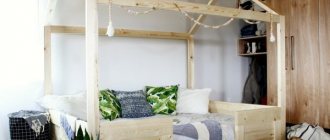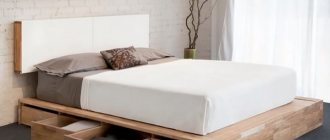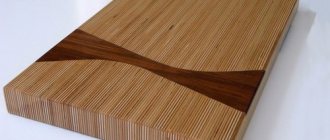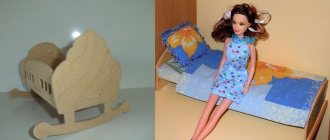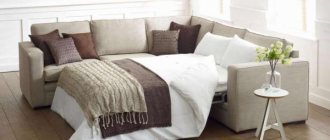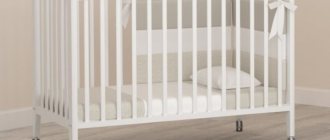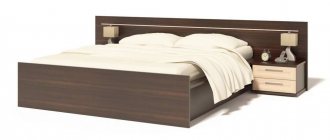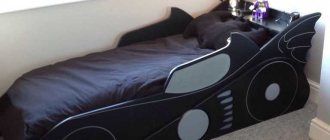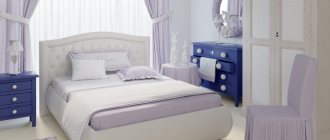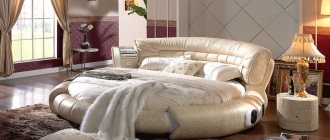DIY plywood bed
Plywood is an interesting material because it is not only flexible and easy to work with, but also incredibly durable. If you decide to make a bed out of plywood with your own hands , this is a smart choice. And believe me, the cheapness of the project is not the main factor, although it is important. Well, there are many benefits of using plywood, and the most amazing one is the dimensional stability of the surface, which furniture made from other woods lacks in most cases. Just check out these 7 plywood bed that you might find useful and will be a great addition to your home. For example, there are wonderful options for a plywood bed with drawers , with built-in bedside tables, plywood children's beds , a headboard and a cozy daybed. With step-by-step photos and simple instructions provided, you can make any of these projects yourself at home.
What is a bed base
A bed base is a mattress support and is essentially the bottom of a bed. The base can be made in the form of a continuous sheet, which is made from boards, plywood, or chipboard. This type of base is heavier in weight and less mobile. The main disadvantage is that a mattress on such a base will not be able to fully demonstrate its orthopedic properties. Accordingly, the quality of sleep also deteriorates.
The orthopedic lattice is an improved type of base. The structure consists of a frame and elastic shock-absorbing lamellas (planks) made of wood and special fastenings.
Features of lamella frames
An innovative solution in the field of furniture production was the creation of lamellas. These are thin wooden plates that are designed to be placed on the surface of frames.
This development allows not only to distribute the weight over the entire surface of the structure, but also creates very good air circulation through the created holes (there are always small gaps between the slats).
Thanks to the air flow, the mattress will be protected from the accumulation of mold and moisture.
All modern furniture manufacturers focus mainly on the production of lamella frames.
Our company uses the most innovative technologies in production, which are used in Europe and the USA,
What does the bed base consist of?
If everything is clear with a solid base for a bed: it is a plywood sheet or boards attached to the bed frame, then the structural features of the orthopedic lattice should be examined in more detail and find out which base for the bed is better.
A slatted orthopedic base is much more complex in its configuration than a solid base for a bed. It is made of straight or concave slats placed at a short distance from each other. The lamellas are attached to the frame using special fasteners - mortise or overhead lat holders. Lat holders are made of rubber or plastic.
Rubber holders provide a springing effect, which gives the bed base a “soft” feel. But if a high mattress of 20 cm or more is used, then this becomes noticeable.
The slats are made from beech, birch and pine wood. It is the properties of wood that give the lamellas different levels of elasticity and reliability. Beech slats are characterized by increased strength and elasticity; their price will be more expensive than their budget counterparts. Such lamellas can withstand even high loads. For people of average weight or teenagers, bases with birch or pine slats are suitable.
Types of bases
Lattice or orthopedic bed bases have various modifications. There are different types of bed bases according to the following parameters:
- Frame type. Manufacturers make metal bases that can last for decades, plastic and wooden grilles.
- Presence of legs. The lattice can be an independent structure on legs or made in the form of separate slats that are installed in the bed structure.
What types of bed bases are there:
- Collapsible. This design is convenient to transport. It consists of the following elements: frame, lamellas (slats), lath holders and legs. The structure is easy to assemble according to the instructions. The orthopedic properties of the base are preserved.
- Solid bases. Ready to use variety. They are produced solid or in the form of an orthopedic lattice made of wood or metal.
- Lifting. These models have a lifting mechanism (manual, gas, spring) that raises the base and provides quick access to the drawers under the mattress. The design will be convenient for small bedrooms and saves space.
- Frameless (liners). They are a tape of lamellas fastened together. The mobile design does not have legs or lathe holders. Installing such a base is very simple - just insert the flexible structure into the bed frames.
- Transformable. This is a premium orthopedic lifting bed base. Thanks to a special mechanism, the transforming base can be adjusted taking into account the position of the body. The structure is lifted by manual adjustment or by remote control. So, for reading or watching TV shows, the head of the bed can be raised. The lower part of the base also rises for a comfortable position of the legs.
- With adjustable hardness. For comfortable use of the base, a design with the ability to adjust rigidity has been created. If you are faced with the question of which bed base to choose, we recommend that you pay attention to this option. Using special attachments on the lamellas, you can change the rigidity of the base, taking into account specific requirements and health conditions. For example, add rigidity structures in the lumbar region. In some models, each slats can be adjusted.
Veneered plywood
Drawings and tips for making a double bed from plywood
The complete set of drawings we present allows you to make a double bed with your own hands in a home workshop. The material of manufacture is laminated plywood and timber, the fastening methods used and the calculated position of the load-bearing elements make it possible to make the bed very stable and capable of withstanding large static loads. To make it you will need a simple set of power tools. It is advisable to perform some operations on stationary woodworking machines, but everything can be done with hand tools.
| Double bed |
Bed parameters
Overall dimensions are selected taking into account the stationary dimensions of the most common orthopedic mattresses today: 2000 mm long, 1600 mm wide and 200 mm high. The height from the floor to the mattress is 416 mm, this parameter is stipulated in the furniture standards, we decided not to change it. The sides with decorative strips are located at the same height as the mattress, but you can make it five centimeters higher - you will feel “protected” while sleeping.
The supporting frame of the bed for the mattress is made of ordinary pine timber 50x50 mm; for the bed you will need approximately seven linear meters of timber. The basis for the mattress is cheap plywood, thickness within 10 millimeters; the plywood can be replaced with wooden slats of the appropriate length or OSB board.
| View from above |
| Front view |
| Side view |
Dimensions of individual elements of a double bed
- Headboard (backrest). Dimensions 1632×650 mm, material of manufacture – laminated plywood 16 mm thick.
- Footboard (front back). Dimensions 1632x400 mm, made of laminated plywood.
- Two sidewalls (kings). Dimensions 2000×200 mm.
- Four decorative posts (two for the headboard and two for the footboard) For the headboard the height is 670 mm, for the footboard – 420 mm.
- Decor for headboards. Two jokes 1632 mm long.
- Frame beam, support for the middle beam and legs for the middle beam. Total length 6700 mm.
- Mattress base. We have already mentioned that you can put any available lumber under the mattress, not just sheet plywood.
To connect the individual parts of the bed together, you need to have wooden dowels, confirmations, minifixes, ordinary self-tapping screws and plugs. The edges are treated with a decorative plastic or paper strip; to strengthen the joint, you need to use wood glue or PVA glue.
Making bed parts
- Headboard. Manufacturing material – furniture plywood. When drawing, position it so that the texture of the laminate is positioned from bottom to top, never position it across. Cut the bottom edge in a semicircle, this will make the structure light. The semicircle is very easy to make using a long string, a pencil and a nail. Exactly the same semicircle needs to be cut for the footboard. On the headboard you need to fasten a block that will hold the central beam; fasten it with ordinary self-tapping screws. The support block should be at a distance of 150 mm from the lower end of the headboard, the length of the block is approximately 200 mm, place it strictly in the center of the part. Decorative strips need to be secured to the sides of the backrest. Ours are square, but you can make them chiseled. To do this, you will have to cut the turned elements in half, the two halves will go on two sides. Fasten with dowels and use wood glue. You need to install another decorative profile along the upper end. You can purchase it at a specialized store or mill it yourself. In our opinion, the second option is preferable; you yourself can choose the most suitable profile section for yourself and set the optimal dimensions. The upper decorative profile is also attached to wooden dowels using glue. The headboard can be secured to the sides using confirmations; the holes must be closed with plugs.
- Foot. The manufacturing process is no different from the process of making a headboard. Just don’t forget to adjust the linear dimensions. Another difference is that the sidewalls should be secured using minifixes. The use of confirmations is undesirable; this is a visible part of the bed and it is very desirable to make it comply with the requirements of state standards.
| Back |
- Sidewalls (kings). The left and right sidewalls are made in a mirror image; fasten 50×50 bars along the drawers with self-tapping screws; the load-bearing structural element of the mattress will rest on them. The drawer side is fixed to the foot with minifixes, and to the headboard it is attached with confirmations. To increase the load-bearing characteristics of the connection, reinforce it with dowels, the diameter of the dowels is 8 mm, and place them on glue. The rules for installing confirmations are standard; be extremely careful when marking. Remember that sheet plywood does not allow you to correct errors; even after small inaccuracies you have to completely redo the connection. The top edge needs to be treated with a decorative profile; secure it with dowels. The bottom edge can be treated with a decorative plastic strip. If you are too lazy to glue it, you can leave the bottom edge as is, just sand it well.
| Tsarga |
How to assemble a bed
The backs and drawers are the basis of the frame; you need to start assembling the bed with them. Mark the joints, drill holes, the diameter and number of holes depends on the chosen connection method. First attach the sides to the headboard, then you can attach the footboard to them. Assemble the central supporting beam of the bed, screw the footrests to it and install it on the horizontal supports of the backrests. You can fix it with self-tapping screws with supports, or you can leave it in a free position.
Place the foundation under the mattress. We recommend using ordinary wooden slats, their length is 2÷3 mm less than the width of the bed along the internal surfaces. The distance between the slats is 15÷20 centimeters, the thickness of the slats is 1.5÷2.0 cm. If there are no slats, use sheet plywood or OSB boards. It is advisable to drill ventilation holes in the solid base under the mattress; place them at the same distance in a checkerboard pattern.
← We make a kitchen cabinet from boards A two-door wardrobe for the hallway from plywood. Option 1 →
We recommend watching:
Plywood FSF | 18mm | 1220 mm x 2440 mm | birch | grade 3/4 | Ш2
4,000 rub.
Plywood FSF | 27mm | 1500 mm x 3000 mm | birch | construction | NS
RUB 7,800
Plywood FC | 4mm | 1520 mm x 1520 mm | birch | grade 3/4 | Ш2
650 rub.
Plywood LAMINATED FOF | 24mm | 1500 mm x 3000 mm | birch
7,000 rub.
Plywood FSF | 15mm | 1525 mm x 3050 mm | birch | grade 3/4 | Ш1
RUB 1,800
Plywood FC | 8mm | 1520 mm x 1520 mm | birch | construction | NS
700 rub
Plywood NEEDLES | 9mm | 1220 mm x 2440 mm | coniferous | grade 3/4 | NSH(PRICE ON REQUEST)
RUB 1,700
Plywood FC | 21mm | 1520 mm x 1520 mm | birch | grade 4/4 | NS
RUB 1,800
Plywood FC | 6mm | 1520 mm x 1520 mm | birch | grade 2/3 | Ш2
1,000 rub.
Plywood FC | 3mm | 1520 mm x 1520 mm | birch | grade 4/4 | NS
350 rub.
Plywood LAMINATED FOF | 21mm | 1220 mm x 2440 mm | birch
RUB 5,300
Plywood FSF | 12mm | 1500 mm x 3000 mm | birch | grade 2/3 | Ш2
RUB 5,900
Plywood FC | 18mm | 1520 mm x 1520 mm | birch | grade 3/4 | Ш2
RUB 2,400
Plywood FC | 15mm | 1520 mm x 1520 mm | birch | grade 4/4 | NS
RUB 1,300
Plywood FSF | 9mm | 1500 mm x 3000 mm | birch | construction | NS
RUB 3,300
Plywood FC | 21mm | 1520 mm x 1520 mm | birch | grade 2/3 | Ш2
3,000 rub.
Plywood NEEDLES | 12mm | 1220 mm x 2440 mm | coniferous | grade 3/4 | NSH(PRICE ON REQUEST)
RUB 1,750
Plywood LAMINATED FOF | 27mm | 1220 mm x 2440 mm | birch
RUB 5,500
Plywood NEEDLES | 6.5mm | 1220 mm x 2440 mm | coniferous | grade SM | NSH(PRICE ON REQUEST)
1,000 rub.
Plywood FSF | 15mm | 1220 mm x 2440 mm | birch | grade 3/4 | Ш2
RUB 3,200
We also recommend reading
11/13/2015 → Beds, sofas
Small compact sofa made of plywood for a summer residence
There are many sofa designs, we offer one of the simplest. Such furniture can be used in dachas, which are rarely visited; it is not difficult to make a sofa, and in terms of convenience it is no different from standard ones.
11/14/2015 → Beds, sofas
The process of making a bunk crib with your own hands
The crib is perfect for small city apartments; you will need very few materials to make it. The time lost depends on your skill and the availability of woodworking machines and tools.
11/16/2015 → Beds, sofas
A bed made of boards for two people - manufacturing algorithm
Many craftsmen dream of making a real double bed, but not many take on this task, they are afraid of difficulties. In this article we will try to convince them that not everything is so scary, that these works can be done independently.
11/21/2015 → Beds, sofas
A simple sofa made of boards and plywood or OSB
We offer you one of the simplest models for making a soft sofa from boards and plywood or OSB boards. All work can be completed in one working day, a minimum of material is needed - the main advantages of the sofa design.
Comments
No one has left a comment yet
Orthopedic base
Many buyers wonder why a bed base is needed if an expensive orthopedic mattress is purchased along with the furniture. Are the additional costs for purchasing an orthopedic base justified?
What is an orthopedic bed base and why is it better than other types of bed bases? An orthopedic base is a special design made of a frame and lamellas, with the help of which the orthopedic qualities of a mattress placed on this base are enhanced.
The slatted orthopedic base, due to its shock-absorbing properties, allows you to create an ideal platform for an orthopedic mattress. This is the best base for a bed because it provides the sleeper with a beneficial effect on the spine, back and neck muscles. Promotes proper rest and restoration of the body.
Advantages of an orthopedic base
An orthopedic bed base has a number of advantages compared to a solid base made from a plywood sheet. Over time, the plywood base is pressed under the weight of the sleeper. This does not happen with orthopedic bases due to the convex lamellas, which provide resistance to the applied load. Due to the shock-absorbing lamellas, an additional orthopedic effect is created and the mattress does not deform in areas of the highest pressure.
Orthopedic bases from a high price category are made of beech wood, which is characterized by increased elasticity and durability. Manufacturers use original technologies in the manufacture of such bases, for example, installing double lamellas to enhance elasticity and better load distribution. This provides the sleeper with quality support.
The undoubted advantage of bases with an increased number of flexible elements per unit area is an orthopedic supporting effect, unloading of the spine, comfort and convenience during sleep. The mattress and the base duplicate the relief of the body, providing maximum comfort and complete rest.
The use of double slats equipped with a slider-regulator will allow you to manually add the required level of rigidity to the sleeping area. Choosing a bed base with wide slats is recommended for overweight people. Manufacturers also offer bases with the possibility of differentiated support for several sleeping areas.
Drawing up a drawing
Before you start creating a bed with a lifting mechanism with your own hands, you need to make a drawing. The project must contain the exact dimensions of all parts, dimensions of the future product, and a list of selected materials and mechanisms. It is important to think through all these nuances in advance. If you do not have such experience, you can find ready-made drawings with already calculated dimensions on thematic resources.
Distinctive features of beds with a lifting mechanism, their advantages
Any of them consists of several points. The first indicates general design parameters, as well as information about the selected materials. The second contains all the information regarding the assembly of specific elements. The third determines the order of actions. The work should be divided into points to simplify it as much as possible. The output will be not just a drawing, but also a ready-made plan with a detailed description of all actions.
Choosing a bed base
Experts from the Mister Slip online store in Moscow tell you how to choose a base for a bed.
- If you need to arrange a temporary sleeping place, for example, in a rented apartment or country house, give preference to products with wide slats and mortise-type lath holders. These designs are distinguished by the most affordable price.
- To equip a permanent bed, pay attention to bases with narrow slats and rubber lat holders. These models represent the optimal combination of comfort, versatility and reasonable cost.
- To create the most comfortable sleeping place, bases with expanded functionality and the ability to adjust rigidity are recommended. By individually adjusting the degree of comfort for a specific zone or several zones, the body recovers faster during sleep and improves well-being.
- For those who prefer progressive solutions, manufacturers offer motorized base options. The owner of such a design will have the opportunity to ensure maximum control over a comfortable body position without effort and without even getting out of bed.
